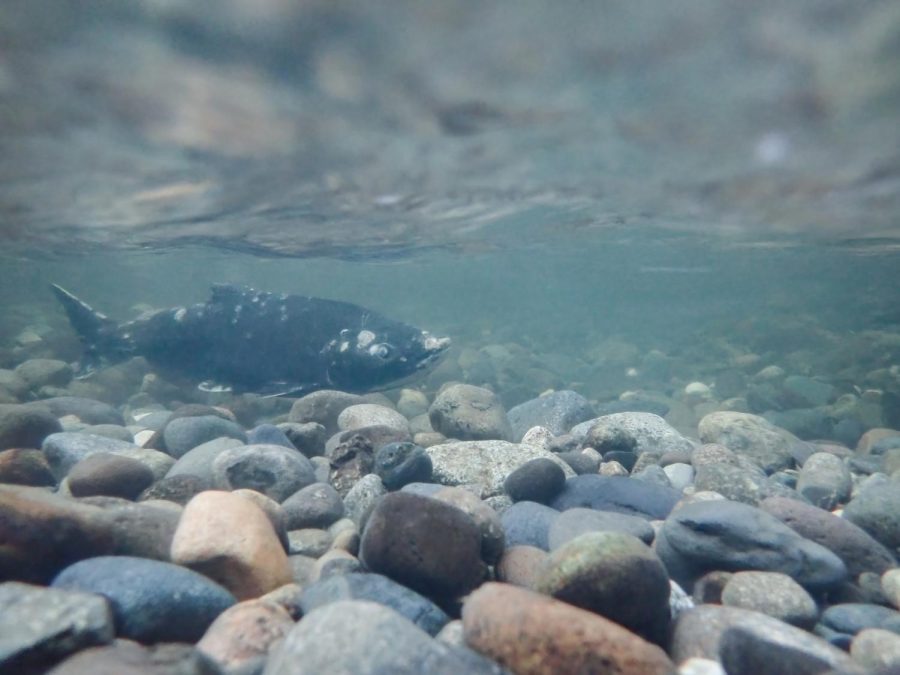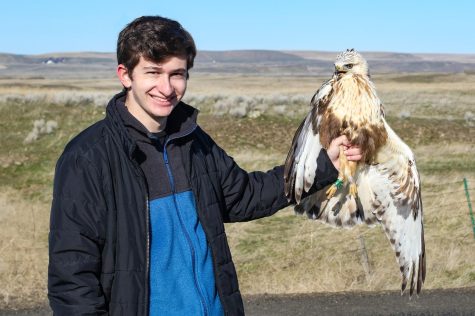Zombie Salmon rise from the dead
This pallid coating and decomposing look is what gives the salmon their “risen from the dead” appearance
A chinook salmon swims against the current in Issaquah Creek, Oct. 18th.
November 3, 2022
A cold shiver of autumn wind brushes through the trees, shaking their yellowing leaves. A handful break off of their branches and drift slowly downward, floating effortlessly towards a rushing, frigid creek below.
As they touch down on the water, they are brushed aside by something churning beneath the surface. A squirming, decaying creature pushes its way forward, chunks of skin missing from its body and fungi eating away at its flesh.
Soon, it is clear this monster is not alone; dozens of these creatures, despite looking more like corpses than living beings, continue to thrash about in the stream.
If this sounds like the description of something out of a horror movie, that is because it is not far off. However, these are not some “creatures from the black lagoon,” they are just salmon, swimming against the current as they reach the end of their life cycles.
Despite these salmon decaying and on the verge of death, they continue to push themselves forward and keep swimming.
Often referred to as “zombie” salmon, Jen McIntyre, assistant professor of aquatic toxicology, explained that these are not quite monsters coming back from the dead.
“When salmon migrate back to freshwater from the ocean to spawn, they begin to die,” she said. “They stop eating and their organs and defense systems begin to fail.”
At this point, the salmons’ immune systems are weakened and rapidly becoming weaker, opening them up to all sorts of infections, she said.
As McIntyre shared, cuts and scrapes the salmon have received on their journey upstream from their interactions with humans, predators and the environment around them can become gateways for bacteria and fungi. Water molds in the genus Saprolegnia, which further eat away at the flesh, cover the affected areas in a whitish film.
This pallid coating and decomposing look are what gives the salmon their “risen from the dead” appearance.
Through WSU’s School of the Environment, professor McIntyre teaches a course on the biology and ecology of Pacific salmon where students learn about the life histories, ecological impacts and even genetics of salmon alongside many other topics.
Evan Barnes, senior environmental and ecosystems sciences major, enrolled in the course and believes he has learned a lot throughout it.
“[This course] has definitely given me a much deeper understanding of the ecology and life choices of salmon … [and] as someone who is trying to work in the field of restoration after college, these are all important topics that I will 100% encounter,” he said.
Though seeing these salmon at the end of their lives can be sad, Barnes has learned through the course that it also signals new beginnings.
Barnes shared his newfound knowledge that the salmon bring large amounts of nutrients sequestered from the ocean into the ecosystems of their spawning grounds and also provide large amounts of food for not only all of the animals that feast on both the living and deceased salmon, but for a large number of people in and around the world and, more importantly, the Native American tribes that rely heavily on these runs of fish for food.
As the eggs for next year’s population have been laid, the salmon soon to die will provide food for scavenging animals and nutrients for the ecosystem before the cycle repeats anew.











